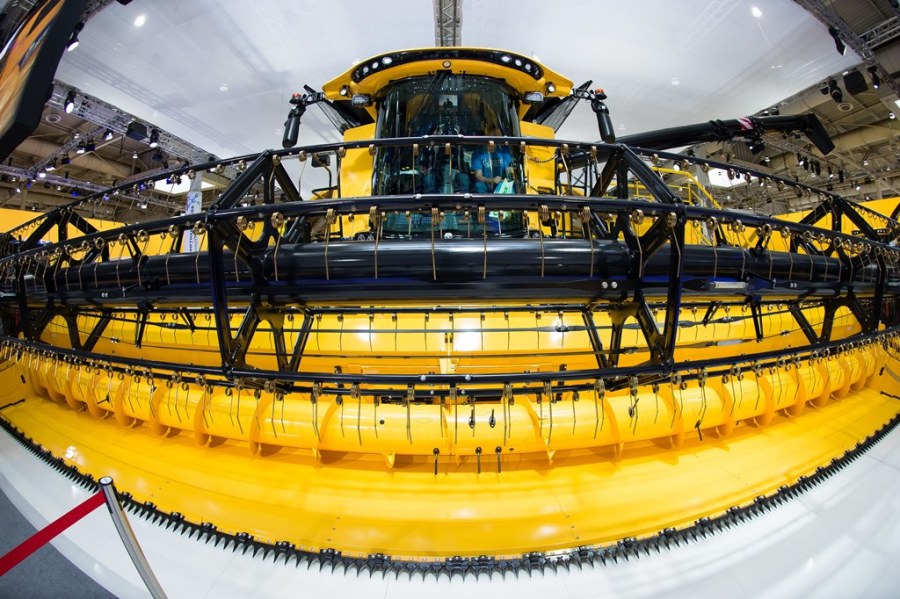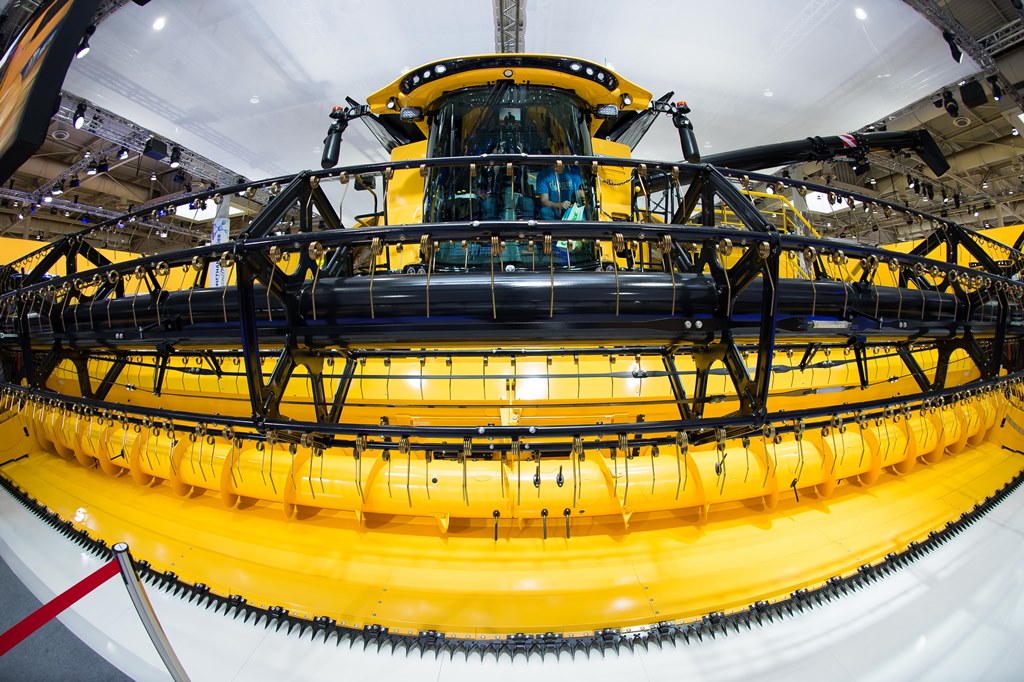 From combines through forage harvesters to balers, refinements and automation are key advances.
From combines through forage harvesters to balers, refinements and automation are key advances.
A powerful new engine lies at the heart of the machine.
By David Jones
A power upgrade for what was already the most powerful combine harvester in the industry sees the CR Revelation model hit the 700hp mark. As a consequence, there’s been a boost to the machine’s productive capability by up to 10%, with improved crop-flow controls and the fitting of Twin Pitch Plus rotors.
In addition, a redesigned residue-management system is said to produce a finer chopper sample and the width of spread now extends to 13.7m. Then, what is described as a functional new colour scheme inside the machine and on its upper sections has been applied to provide better visibility during harvesting and for the purposes of daily maintenance.
Accompanying the Revelation at LAMMA will be New Holland’s latest generation of large square baler, the BigBaler 1290 Plus. Differences to what has gone before include up to 10% more bale density, the addition of Smart Baling technology to increase machine capacity and bale quality, greater durability, improved reliability and more in-field productivity. A new biomass kit has been added to counter any difficulties caused by stiff or stalky biomass material.
Moving on to the NH range of forage harvesters, a new flagship model – the recently launched FR920 Forage Cruiser – benefits from the introduction of two new heavy-duty crop processing elements, DuraCracker and DuraShredder.
A powerful new engine – the FPT industrial V20 – lies at the heart of the machine and facilitates high performance crop feeding. This power is conveyed via a new heavy-duty driveline, with a mechanical 4WD option available to ensure that all the necessary torque required for the job is effectively transmitted onto the ground.
The Forage Cruiser has a choice of three crop processors – the two mentioned above, plus the standard crop processing rolls – which, when combined with the patented HydroLoc technology, ensures uniform chop length independently of throughput and crop type.
Krone
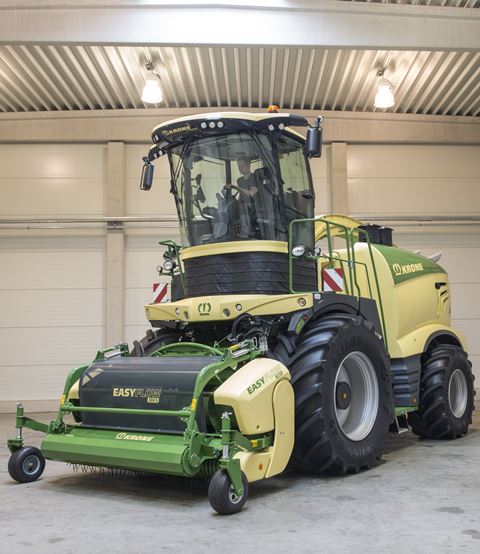 A world first is being claimed by Krone for the new cab-lift feature on its BiG X 880 forage harvester – at the touch of a button on the main console, the entire cab can be raised by up to 70cm on a hydraulic scissor lift. The aim is to enhance visibility over the crop ahead and of the adjacent trailer. All-round visibility from the cab – which, itself, is a new design – is further improved by 360° multiple screen wipers.
A world first is being claimed by Krone for the new cab-lift feature on its BiG X 880 forage harvester – at the touch of a button on the main console, the entire cab can be raised by up to 70cm on a hydraulic scissor lift. The aim is to enhance visibility over the crop ahead and of the adjacent trailer. All-round visibility from the cab – which, itself, is a new design – is further improved by 360° multiple screen wipers.
In addition, the BiG X range has been extended by the addition of three new models – the 680, 780 and 880. There’s a choice of seven tank sizes to meet individual circumstances, while the power options culminate in the 880 model in the shape of a Leibherr, Stage 4/Final Tier 4-compliant engine.
The 780 version is also available without emission treatment technology, making it exempt from European statutory emission standards, as its output exceeds 560kW. In terms of machine handling, Krone has prioritised improvements in manoeuvrability by specifying independent wheel suspension – a feature that comes into its own when tight turns and undulating fields are being negotiated.
To mark 40 years of producing round balers, Krone has bestowed on its Comprima range a number of upgrades, the most noticeable of which involve a re-design of the cover and panel, together with a new lighting system, including LED work lights. With single or tandem axles and a choice of braking systems and tyres, all models are ISOBUS compatible.
Fendt
In introducing its two new Katana forage harvesters – the 65 and 85 – Fendt states that the more varied the conditions, the more they come into their own. When dealing with grass crops, for example, sloping terrain, soft ground and variable degrees of moisture don’t compromise machine performance. The wide cutter head and six feed rollers have been so designed and specified with the aim of widening harvesting windows.
In maize, too, these machines are claimed to be equally effective, whether the crop is destined for fodder or the biomass digester. In the case of the latter, the greater the precision in cutting the crop, the more energy it will produce subsequently.
John Deere
An 8000 Series self-propelled forage harvester, fitted with the latest version of the HarvestLab sensing system will be present for close inspection for the first time at LAMMA, along with the S700 Series automated combine and V Series variable chamber round baler.
First introduced as a concept in 2007, the new system – HarvestLab 3000 – requires less maintenance, can operate in a wider range of temperatures and has the capacity to store more data. The web interface, when used for stationary measurements away from the forager, has been made more operator friendly.
For 2018, JD is also introducing a new 12-row rotary drum maize header – the 490Plus – with a double-folding header for improved visibility during transport. It’s been designed specifically to feed high horsepower foragers working in high-yielding varieties in a wide range of conditions.
Massey Ferguson
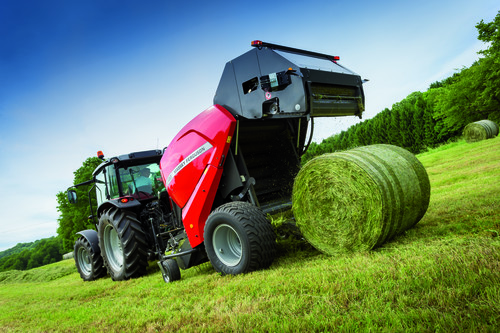 In addition to the new Ideal range of combines, MF has introduced a number of new balers, hay tools and mowers, many of which will be making their UK debuts at LAMMA.
In addition to the new Ideal range of combines, MF has introduced a number of new balers, hay tools and mowers, many of which will be making their UK debuts at LAMMA.
One of them is the five-model range of RB round balers, which will be offered in a number of fixed- and variable-chamber configurations to suit a wide span of users – from smaller stock farms up to large-scale contractors.
The highest density bales – weighing 20% more than those produced by its predecessor – are claimed for the new MF 2370 UHD large square baler. It’s said to be the highest performing large square baler ever built at MF’s iconic Hesston plant in the US. The point is made that this increase in bale weight and density leads to reduce both in-field handling and the costs of transport.
Grimme
LAMMA visitors should find the German manufacturer’s stand easy to spot, dominated as it will be, by a six-row, 530hp Rexor 620 two-axle sugar beet harvester, accompanied by a GT 170 trailed two-row potato harvester/elevator.
Perhaps the most noticeable aspect of the Rexor is the offset positioning of the wheels – left and right – for lifting, a feature that allows the machine to move over the entire soil surface during the course of operation. Six axial rollers, followed by three cleaning turbines, are designed to perform an effective separation of soil and trash.
Grimme states that the intelligent drive technology, with a matched hydraulic and cooling system and auto-drive in the 1150-1500rpm speed range, combine to make the Rexor 620 the most economical beet harvester in its class.
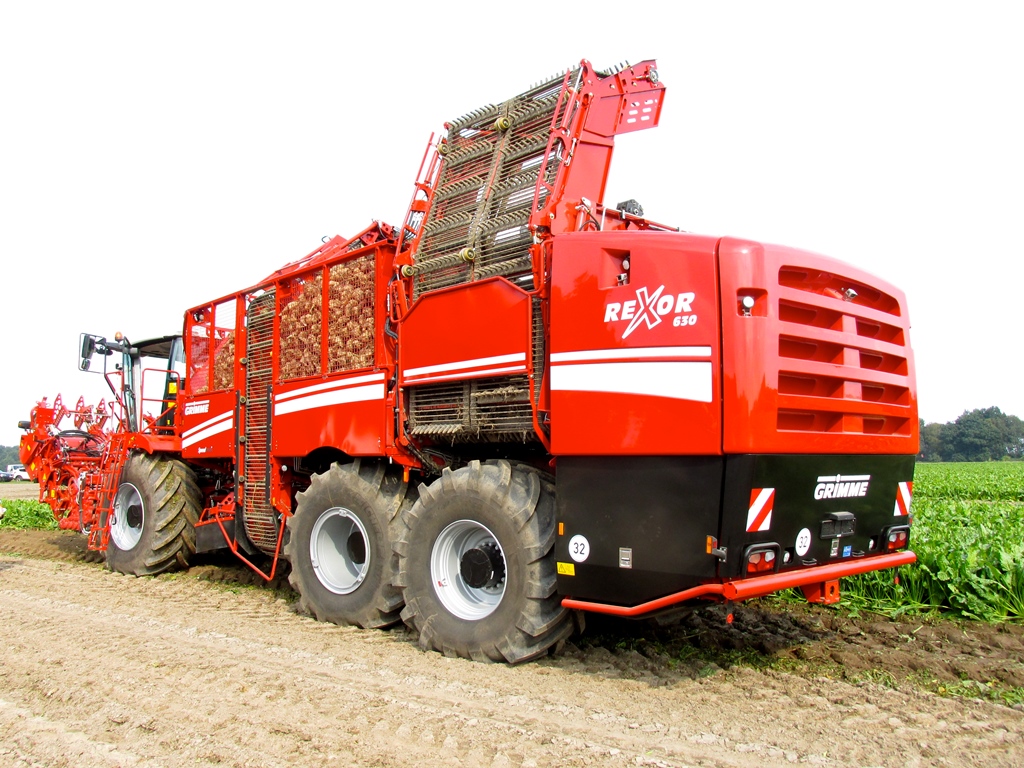 The GT 170 potato harvester is available in two models – M and S, giving differing frame lengths – with a choice of four different separators to meet individual needs. Delivering high capacity harvesting and gentle crop handling, the GT 170 incorporates TerraControl hydraulic ridge pressure relief and individual depth control.
The GT 170 potato harvester is available in two models – M and S, giving differing frame lengths – with a choice of four different separators to meet individual needs. Delivering high capacity harvesting and gentle crop handling, the GT 170 incorporates TerraControl hydraulic ridge pressure relief and individual depth control.
The Double MultiSep separator is designed to deal with even the heaviest harvesting conditions and, with the patented Vario-RS roller distance adjustment, the machine can react to different crop sizes at any time, without changing the roller.
Deutz-Fahr
Four years after its introduction, the C9000 Series combine harvester model has been significantly upgraded for 2018 to become the 9300 Series. The 340hp and 395hp Mercedes engines are now Stage IV emissions compliant, while the cab and control features have been completely re-designed. In addition, the grain tank is now 10% larger and the unloading speed 30% faster.
Inside the CommanderCab V1, the control elements are now integrated into the armrest of the new, extra-large seat and are based on the control set-up of the company’s larger tractors. The monitoring system provides the operator with a clear overview of the machine’s performance, loss display and all warnings.
The balance system is now operated by the use of a joystick, which facilitates reassuring control over rugged terrain. With up to 20% lateral and 6% up/down hill compensation, it helps to achieve optimum harvesting performance in more challenging conditions.
Further back on the machine, the straw hood has been re-designed to promote a smoother flow of straw, including when chopped. A new spreader allows the operator to adjust the flow of chopped straw to match working conditions and, while discharging long straw, can be converted into a chute to boost the flow of straw being discharged.
The new model’s grain tank has also had its capacity increased – to 10,500 litres. A new two-feed system has accelerated the discharge speed through the new unloading pipe to 120 l/sec. Furthermore, when the new 6m grain tank outlet pipe is being closed, the feed screw induces a slight change in the running direction and as the crop flow is halted, no grain is lost.

